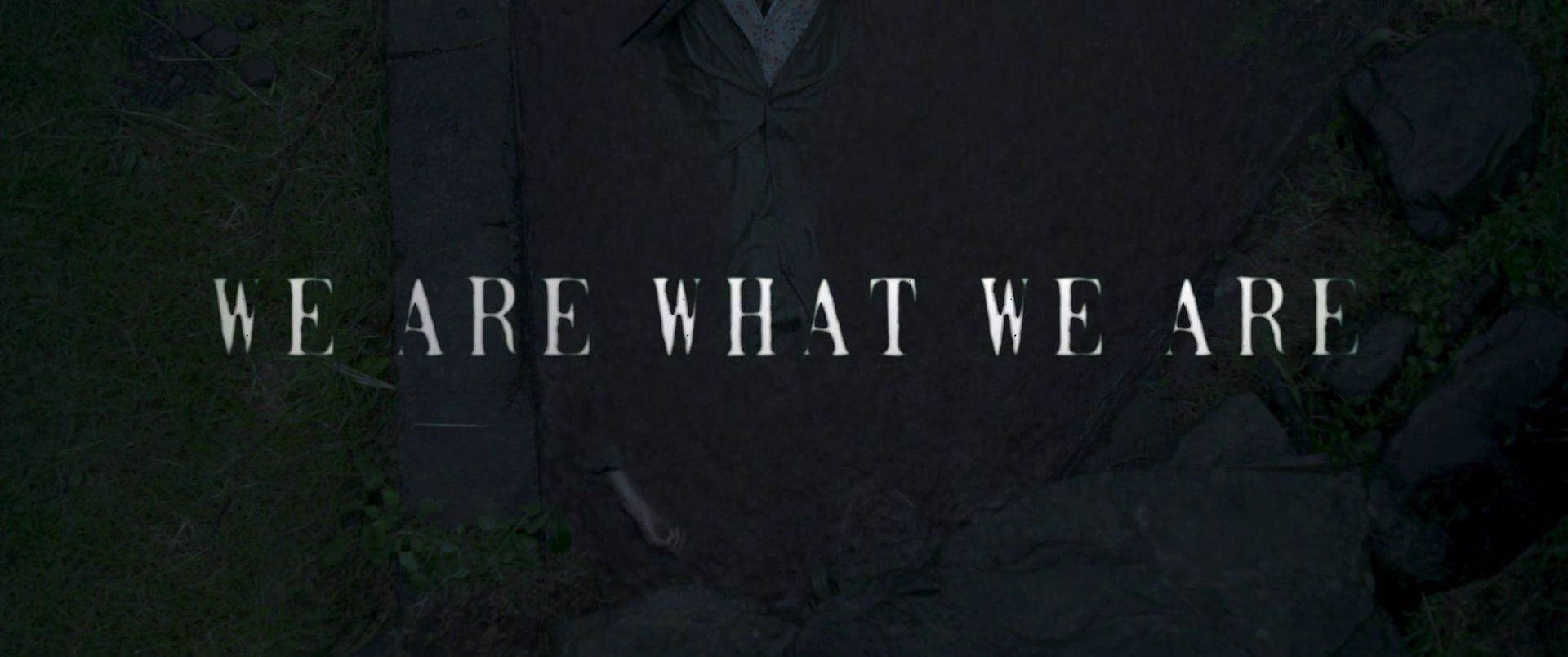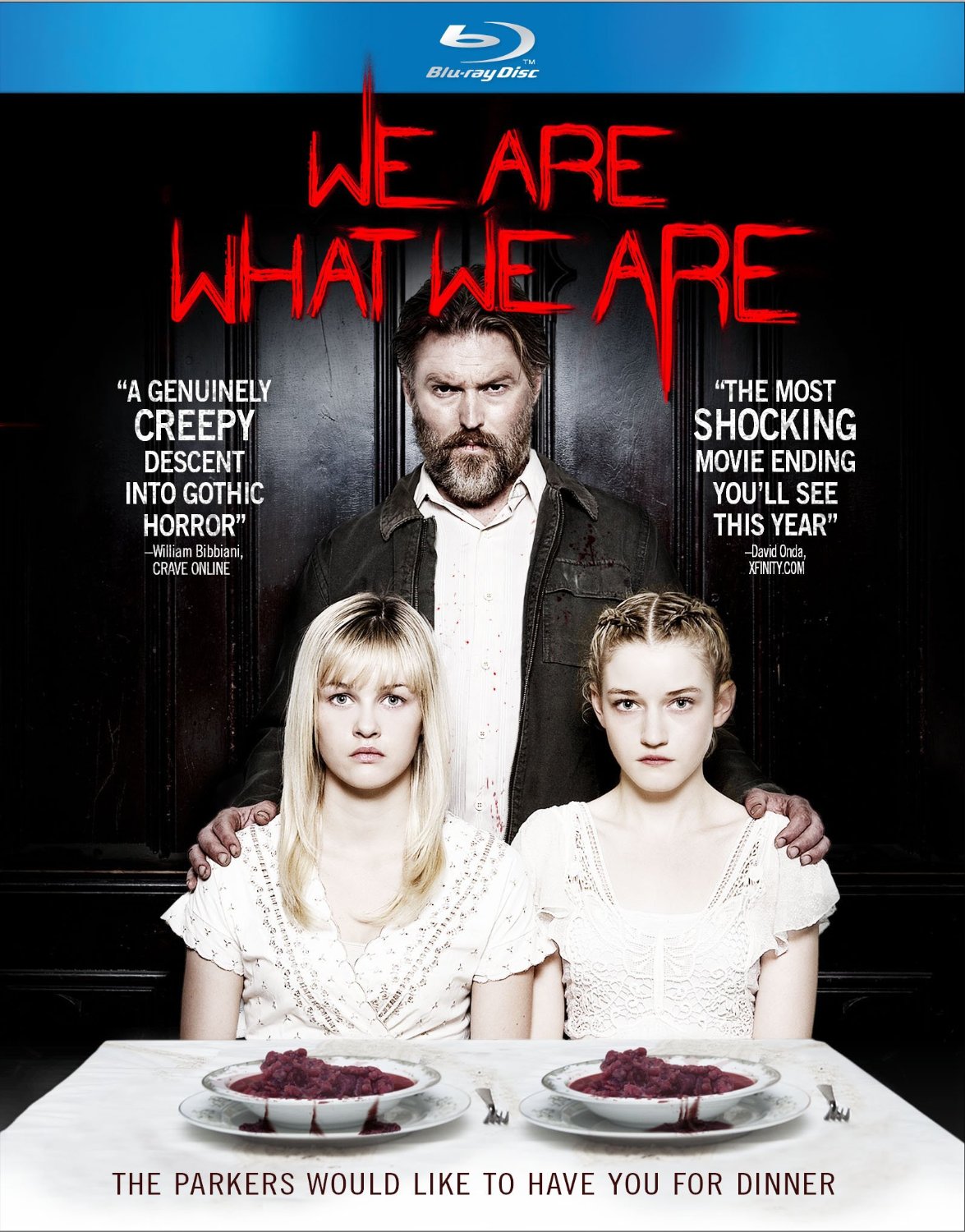
 BUY FROM AMAZON: CLICK HERE!
BUY FROM AMAZON: CLICK HERE!
MSRP $24.98
RATED R
STUDIO Entertainment One
RUNNING TIME 105 Minutes
SPECIAL FEATURES
• An Acquired Taste: The Making of We Are What We Are
• Interviews with Director Jim Mickle, Bill Sage, and Julia Garner
• Audio Commentary With Cast and Crew
The Pitch
A secluded family in the Southern United States with oppressive religious beliefs and a hunger for human flesh? Now there’s a fresh angle!
The Humans
Bill Sage, Julie Garner, Ambyr Childers, Wyatt Russell, Michael Parks
The Nutshell
The Parkers, a seemingly wholesome and benevolent family, keep to themselves, and for good reason. As they struggle to keep their ancestral customs intact, local authorities begin to uncover clues that bring them closer ot the secret that they have held closely for so many years.
The Lowdown
Tradition is weird. Who can say why we do the things we do the way we do them, and why the way that seems normal to one group is strange and foreign to another. This concept has been a common subject for horror since people started telling scary stories at the dawn of time. There’s something unsettling about ritual, particularly among an isolated community. Whether it’s Shirley Jackson’s The Lottery, Thomas Tryon’s Harvest Home, the creepy villagers from H.P. Lovecraft’s The Shadow Over Innsmouth or more contemporary examples like The Wicker Man, Dog Tooth, Population 436, and Jug Face. It’s a good low budget way to dial up the creepy but actual quality varies widely depending on whether the creator had any ideas beyond “isolated group with weird traditions.” So how fares We Are What We Are?
We Are What We Are is a remake of a 2010 Mexican movie of the same name (but, you know, in Spanish). I have not seen the original but a plot synopsis has told me that the only similarities are that it’s about a family of cannibals that loses a parent and has to move on, hopefully without being caught. I suspect it’s a “remake” because somebody liked the title. The movie is really more a mash-up of Frailty, The Hamiltons, and (to a lesser extent) Martin.

The face of true evil looks like the love child of Ron Swanson and Grizzly Adams.
After their mother drowns in floodwater, the Parker girls, Iris (Ambyr Childers) and Rose (Julia Garner) come to terms with their familial responsibilities as the family holiday “Lamb’s Day” approaches and their father is too sickly and weak to go through with the necessary preparations of killing a kidnapped human being and preparing them as a big meal after days of fasting. That may seem like a spoiler but it’s the movie’s worst-kept secret: if by some miracle you have missed the picture of a woman with lines on her body dividing her into various sections of meat on the back cover of the box then you would still have to be willfully ignorant to miss all the incredibly unsubtle hints the movie drops along the way. It doesn’t really matter that the story can’t keep the secret under wraps, though, because this movie is about cannibalism the same way that Psycho was about knife murder. Once we establish what our protagonists are up to and (sort of) why, it becomes a question of when they will get caught.
The flood that’s indirectly responsible for the death of Mrs. Parker begins washing up human remains from an area with no known cemeteries, but the town sheriff can’t find any fucks to give despite the town doctor’s (Michael Parks) assurance that something fishy is up. The sheriff thinks the doctor is being paranoid due to the disappearance of his daughter some years earlier and because now is no time for small-town law enforcement to be mildly competent in a horror movie. So the doctor turns to a young deputy (Wyatt Russell) who happens to be sweet on Iris Parker. The movie then becomes a slow burn as we wait for Plot A and Plot B to meet in the middle and watch the cops fail to do anything right in various red-herring scenes in between.

Kurt Russell + Goldie Hawn = The fat dumb brother from Home Improvement, apparently.
This movie has a much stronger cast than it really deserves. I don’t need to tell anyone that Michael Parks is amazing because that’s a matter of public record at this point, but he’s also not incongruously better than anyone else in the cast. Both Julia Garner and Ambyr Childers anchor the movie with two similar but very different characters who approach the situation in their own way. Bill Sage as the family patriarch is the real scene stealer and he often out-acts Parks. The scene where Sage and Parks finally face off across the dinner table from one-another is probably the best scene in the whole movie and the whole reason to watch, if I’m being honest. Even supporting characters like Wyatt Russell’s Deputy Anders and Kelly McGillis’ neighbor lady Marge ensure that there’s not a single wink link in the cast. It’s just a shame that such a great group of actors is wasted on an incredibly sparse plot.
We Are What We Are is never boring and I credit that to the cast because there’s enough plot for, at most, an hour of film even though it clocks in at nearly two. As I said, hints that the Parkers are cannibals are incredibly easy to read, but the movie just keeps pussyfooting around the reveal as though it’s some grand Hitchcockian twist that’s going send monocles a-flying when the curtain is finally pulled back. The movie is over halfway done when it finally delivers its thesis statement and only then does it decide to progress the plot by having Parks and Russell start poking around in the mud until they come to the obvious answer. There are some attempts to do something with the characters during the downtime but two don’t pay off until nearly the end and the rest don’t go anywhere at all.

Michael Parks is dumbfounded and a bit annoyed to see that anyone can play a more terrifying religious nutcase than he did.
Like many other ritual movies, We Are What We Are hints at something deeper than tradition underneath the surface. Is Frank’s religious zealotry a justification of his actions or does it hint at something more supernatural? Much like Martin, the movie tries to have its cake and eat it too with an ambiguous reveal but unlike Romero’s movie it does it in a ridiculous gore set-piece near the end of the movie. If the Parkers aren’t vampires, ghouls, or wendigos of some sort than the end is just so laughably pulpy and over-the-top that it steals all its own themes and ideas about family, tradition, and evil. Is the scene really unexpected and fucked up? Yes it is, it’s extremely effective, but a film’s big climactic showpiece shouldn’t collapse under the strain of its audience thinking about it for a couple of seconds.
I have one other gripe on the plot and this seems to come up in all cannibal movies, so it’s a bit of a pet peeve. Do you eat meat? Have you ever looked at a cow and thought “I’d love to hack off a leg and gnaw it like a dog or chew a big bite out of its face.” Of course you haven’t, so it stands to reason that just because someone has a craving for the long pig, it doesn’t mean that they are constantly fighting the urge to just sink their teeth into a person’s neck like a leopard. I don’t know how this trend got started but it’s like carnism as understood by a small child in an isolated militant vegan cult. I know you’re trying to show that cannibalism is savage and horrible but this is lazy film-making, please stop doing it.
I know it seems like I hate this movie, and looking back on what I’ve written I can see I’ve built a pretty solid case agaisnt it. So it perplexes even myself when I say that I think it’s pretty good. Conceptually, We Are What We Are is an awful movie with very little going for it, but the production is stacked with genuine talent, the cinematography is excellent and atmospheric, the sound design and composing set the scene perfectly, and Jim Mickle directed the hell out of this picture. This movie is genuine proof that one really can polish a turd.
It moves at a good pace even if very little is actually happening and good acting makes flat characters compelling. It has very little to say and what it does have it says rather clumsily, but I still found the story captivating. We Are What We Are is a junk food movie, but one of the highest quality. Take that however you like.
The Package
There’s a fair amount of special features but they’re all pretty skippable unless you just really want to know all the details about this movie you possibly can. In that case you’ve got an audio commentary, a “making-of”, and some interviews.
The disc is in 1080p Hi-Def 2.35:1 with DTS-HD Master Audio and has English subtitles.
Rating: 




Out of a Possible 5 Stars